The Importance of an Effective Practice
By Justine Williams
USPSA Grand Master
"How do I practice?” is one of the questions that I’m asked most often. This is a tricky question because if done incorrectly, bad habits can begin to form, and these will be difficult to break. I will be explaining what practice is, and how I practice so we can run an effective practice and successfully build up our skills.
So, what is practice? By the dictionary definition it “is performed (an activity) or exercise (a skill) repeatedly or regularly in order to improve or maintain one’s proficiency.” I believe practice is more than that. In any competitive environment, to be great, practice is essential, and let me tell you IT WON’T BE EASY! Some days you’ll be killing it and doing the best you have ever done, and on other days, you won’t even be able to do the most basic of skills. That is the hardest part to expect.
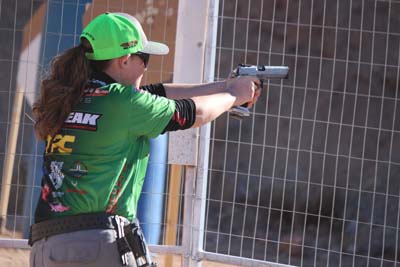 You should always come up with a game plan on what you will be practicing before you start; Have each drill mapped out and stay on track. This saves you time and will allow you to focus on accomplishing these goals instead of dilly-dallying around. You also should have all your gear ready and prepared the night before. Ammo should be loaded, gear should be put together, and your magazines should be loaded.
You should always come up with a game plan on what you will be practicing before you start; Have each drill mapped out and stay on track. This saves you time and will allow you to focus on accomplishing these goals instead of dilly-dallying around. You also should have all your gear ready and prepared the night before. Ammo should be loaded, gear should be put together, and your magazines should be loaded.
Once you get to the range, STAY FOCUSED! It’s easy to get sidetracked when people come and talk to you or you see an old friend, but this will really cut into your practice time, meaning less quality practice. Limit conversations to five minutes max, and you’ll be right back on track.
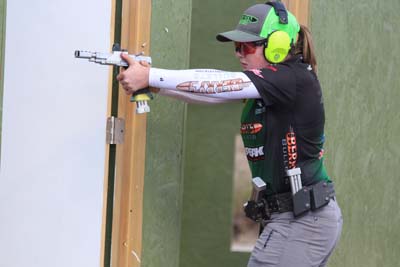 Keep a journal, preferably with a pen and paper. Statistics show that people learn and retain more if they write it down themselves. This is very important and will help you track your progress; instead of starting two clicks behind where you left off, you can start right where you left off!
Keep a journal, preferably with a pen and paper. Statistics show that people learn and retain more if they write it down themselves. This is very important and will help you track your progress; instead of starting two clicks behind where you left off, you can start right where you left off!
When I am practicing, I always start with accuracy shots which normally include head shots anywhere from 25 yards to 35 yards. This step helps me confirm that my gear is running properly, and that my head is in the right mindset to have a productive practice session.
You should then move on to the main portion of your practice. This will include drills that you need to work on, or your opportunities. To continue to improve, we need to practice these things regularly. I tend to do three to four drills depending on their intensity, and how many rounds each drill requires.
My favorite drill that really helps me tune my shooting and improve my skills, is what I call the three-target drill … easy enough to remember. You will set up three different targets with three different target presentations at 7 yards, 12 yards, and 20 yards. You will start off with a baseline par time. The par time gives you a start on stop signal on your timer. This will give you a margin of error. You will then slowly decrease the par time. Once you have reached the time/point where you start to make mistakes, stop and think about what is breaking down in your fundamentals and go again. This really helps me with draw, transitions, splits, target acquisition, aiming, and reinforces the basic fundamentals. You must remember to be careful not to just waste ammo. Every bullet has a purpose and when you miss, think about what happened and what can you do to fix it.
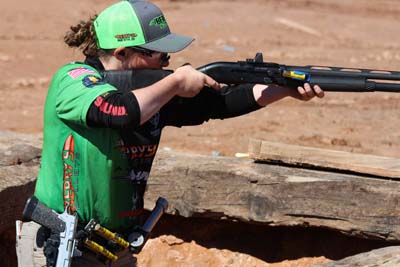 Once you have reached the end of the main part of your practice you should be mentally and possibly even physically tired. I love to end my practice with a fun game whether I am by myself or with someone. I like to incorporate what I worked on from that practice session. Make up your own drill, be creative about it and make sure you are using and applying the skills you learned from that day.
Once you have reached the end of the main part of your practice you should be mentally and possibly even physically tired. I love to end my practice with a fun game whether I am by myself or with someone. I like to incorporate what I worked on from that practice session. Make up your own drill, be creative about it and make sure you are using and applying the skills you learned from that day.
One of my favorite games to play at the end of my practice is the Diminishing Dot game. For this game, I use the Tactical Performance Center Diminishing Dot Target. There are several different ways to play this game. The most common way to play is that you have an unlimited amount of time on all the strings of dots. You will start with your gun loaded and holstered at 5-7 yards. You will then begin at the largest dot and you will take one shot. If you hit the circle move on to the next smaller dot. If you miss, you are out. This cycle continues until you have a winner. If two people tie, then the tie breaker is determined by having the two participants shoot strong-hand only at the smallest dot. If you tie again, then you’ll shoot the smallest circle weak-hand only. The person that hits the dot, wins. This is such a fun game and really helps you focus on building and maintaining your fundamentals.
After you’re done with your game write down notes from your practice in your journal. Make sure you are writing things down in a positive manner, because putting yourself down will not help you progress. You can write opportunities but try to put them in a positive manner. Write down what you worked on that day and what you would like to work on the next time you go out to practice.
All these steps will help you improve your skills. Practice will be difficult at times but remember to stick with it and push through the hard times.
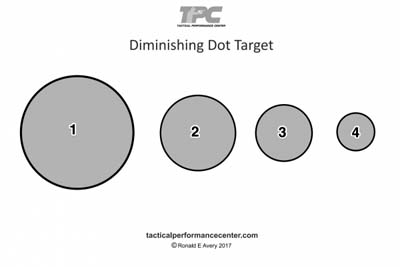 Diminishing Dot Game
Diminishing Dot Game
Summary: This exercise is another vision “See What You Need to See” honing tool. You might guess, correctly, that we think Seeing What You Need to See is important.
Time: 30 minutes
Rounds: 100 live, 100 dry
Target: Diminishing Dot
Start Position: Compressed Imminent Threat, 3 to 7 yards (based on skill)
Dry Variant: Same as Live
We’ve numbered the targets, but don’t use a version with numbers on them. You need to start thinking about hitting regions, not spots. They are numbered here to help you plan the exercise.
1. Commit to doing this at the pace of doing it RIGHT. Right now … look at each target and decide what you need to see on each.
(Hint … try an ever-improving sight picture in a circle smaller than the actual target. What you need to see for #4 will be much tighter and precise than #1, probably using the tip of the front sight, not the post).
2. For at least the first 10 reps, step away, and step in and rebuild your stance and grip from scratch each rep.
3. Do this dry first. Then hot.
4. Present to circle 1, then shoot 2, 3, 4 – 4 times (16 rounds)
5. Present to circle 2, then 3, 4, 1, 2 – 4 times (16 rounds) 32 rounds
6. Present to circle 3, then 4, 1,2,3 – 4 times (16 rounds)
7. Present to circle 4, then 1,2,3 – 4 times (16 rounds) 64 rounds
8. You now have 46 rounds left. Do 10 rounds of any sequence you want. Play with it, have fun.
9. You know have 6 rounds left. Present to the TPC logo and eliminate it.
10. Write down what worked in your journal. Write down ideas for improving.
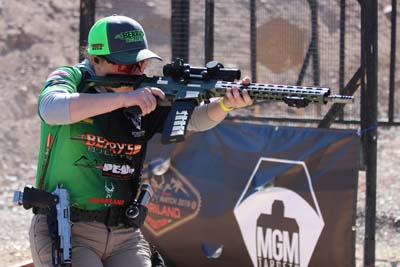 About the Author
About the Author
Justine Williams is a 15-year-old USPSA, 3-gun, IPSC, and Steel Challenge competitor. Justine is also the youngest Grandmaster in USPSA Production Division. She made Grandmaster at the incredible age of 13. Justine is currently 2-time Production IPSC National Champion. Justine competed on the men’s Production team at the 2018 Pan American Games and won a Gold in Ladies Production, a silver in the Production Team event, and a bronze in the Production shoot-offs, as well as 2 Presidential medals. She has won over 80 titles in level 2 and above matches. Justine is a straight-A student and enjoys riding and training horses. Justine also has a passion for instructing.

